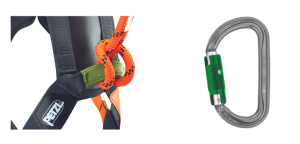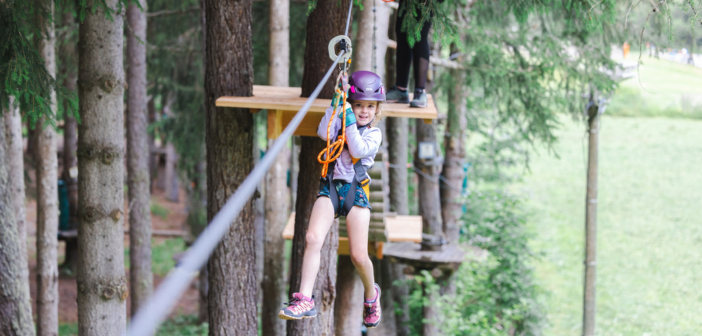Delicate cargo requires proper handling. Harnesses for kids need to fit properly and be attached to belay lines or lanyards in such a way as to provide maximum fall protection. That’s not significantly different from what’s expected of adult harnesses. Indeed, most kids’ harnesses are simply small versions of adult harnesses, and in many applications, that can work just fine. But there are special considerations in choosing harnesses for kids that might be different from what goes into the choice of an adult harness.
Sit or Full-Body?
Perhaps the first question is: When is a sit harness adequate for kids, and when should a full-body harness be used? Gear company executives and other industry insiders generally agree that in virtually all cases, a full-body harness is the way to go. But there are some exceptions where a sit harness can work.
Kim Lawrence, co-owner with husband Kevin of Arboreal Edge, which, among other things, builds ropes and challenge courses, largely for summer camps, says that a sit harness can be a choice on a course where each participant is being constantly belayed by a guide. Similarly, Blair Williams of Edelrid says, “The only place I can imagine using a seat harness is on a climbing wall.”
A sit harness has two distinct advantages: it is easier to put on and fit (a major consideration when outfitting a group of hyperactive, fidgety kids); and it is typically more budget friendly.
However, a sit harness is more susceptible to allowing its wearer to twist and turn into an awkward, uncomfortable, or possibly injurious position after a fall. With a guide present, awkward positioning can presumably be quickly corrected, but that isn’t the case on a course where kids are self-belaying. A full-body harness, says Lawrence, does a much better job of maintaining “[body]orientation when kids are on their own on a course.”
With all the variety available in harnesses, how is an operator to choose among them? The considerations include ease of fitting, versatility in fitting, course design (and the particular course features involved), common group sizes, staff-to-participant ratio, and total throughput on a course.

Left: The Edelrid Radialis has six Easy Glider buckles, an adjustable back plate, and a universal webbing belt with a wide adjustment range. Middle: The French Creek 4330-XS has fixed buckle connections so they cannot be taken apart, and an additional chest connection point to keep a rider upright. Right: The youth-sized RPE EZPZ has a simple waist adjustment and an easy-to-adjust back design to fit most body shapes.
Fitting
Fitting might be the biggest challenge, because, as Colin Lynch, park manager at North Shore Adventure Park in Silver Bay, Minn., points out, kids vary in size quite a bit, “and we have had some struggles with proper fit for our youngest guests.” In other words, the difference in size between, say, a 4-year-old and a 13-year-old is enormous, and simply having one type of harness for all kids might not work.
Lynch says that North Shore’s go-to harness for kids age seven and older is the Deimos Quick3. For younger and smaller kids, the choice of many parks is Petzl’s Ouistiti, for kids weighing 30 kilos (66 pounds) or less. (Petzl’s Ben Eaton notes that the Ouistiti is “for toddlers” and suggests the Simba Park for larger kids.)
Stocking a variety of harnesses might be a way to accommodate many sizes and applications, but it has its drawbacks. As Cody Greene of Ropes Parks Equipment points out, “having the same harness on all participants means not having to adjust two different styles.” That concern is particularly in play with kids’ harnesses, because kids typically need more help with fitting than adults do. And it is obviously an important consideration when it comes to staff training.
How easily and quickly fitting adjustments can be made is perhaps a more important consideration in choosing a kids’ harness versus an adult harness. Most adults can, by following instructions, do most harness adjustments on their own. Kids … not so much. Not only do kids need the hands-on help of guides or staff to get snugly fitted, they can be hyperactive. And in dealing with, say, a school group of 20 or more, the overall fitting time for the group can become problematic if more than a minute or two per kid is required—keeping kids waiting is usually a recipe for chaos. Lawrence suggests training non-guide staff to do harness fitting for an all-hands-on-deck approach to dealing with larger groups.
When it comes to fitting, some kids’ harnesses come with front adjustment points, while some, like the Ouistiti, reverse that scenario and have all adjustments at the rear. The advantage to the rear-adjustment design is that it keeps strap adjustments, especially the waist adjustment and closure connection, well away from curious young hands.
However, Sam King, operations manager at Tree Trekkers in Frederick, Md., goes with the Edelrid Radialis Comp Junior, with adjustment buckles up front. That makes life simpler for staff, he says; the same adjustment process is applied as with adults using the full-sized Radialis Comp. He says that staff vigilantly watch young participants for any chance that the all-important waist-band adjustment changes.
Vigilance is, of course, inherently the name of the game when kids are involved. As Kenny Brolin of Kong points out, kids in a park or camp require “a higher level of supervision.”
“We don’t want kids messing with carabiners or adjustments,” says Lawrence. To prevent fiddling, Petzl has positioned adjustment points on its Simba Park harness, as with the Ouistiti, on the back, out of the reach of little hands. The belay connection still needs to be on the front of the harness, but Kong’s Brolin says that “a triple-action or locking carabiner (as a connector) is almost impossible to open.”
One example of a kid-proof carabiner is Petzl’s Am’D Pin-Lock carabiner, which can only be opened by a guide with a pin-like tool, preventing kids from disconnecting themselves. A Pin-Lock device is also included on the Simba Park for its rear-closure system.

The Petzl Ouistiti is foam-lined for comfort. Its front attachment point is positioned to limit the risk of a child flipping, and its adjustment system is positioned on the back to make it harder for children to access.
Matching Harness with Activity
Some harnesses work better than others depending on the application or combination of applications: climbing, canopy touring, zip lining, etc. For example, King says that Petzl’s Simba harness works great when lots of climbing is involved, but he prefers the Edelrid Radialis Comp when “horizontal traverses” are the principal feature. (It should be noted that the Simba comes in two versions: one designed for climbing, the other specifically for adventure parks.)
“It depends on the course and who’s building it,” says Chris Williams of French Creek, which makes the 4330-XS harness to fit smaller kids, under the brand of Adrenaline Gear. Different park designs or different activities might call for different harness types.
Lori Pingle, co-owner of ZipZone in Columbus, Ohio, says that while the Petzl Ouistiti is nice for climbing applications, “I don’t like the design for zip lines because of the lack of a waist strap. The Edelrid Radialis Comp is better if the participant will often be suspended in the harness (e.g., on a zip line),” she says.
Another important consideration is the location of the belay connection clip on the front of the harness. For the most part, as with adults, a sternal connection to the lifeline is the usual set-up, unless the harness is being used for a “leap of faith” or another element where the participant must jump forward. For such a scenario, Edelrid is introducing, for 2024, dorsal attachments for the Radialis Air and its junior version.

Left: The Petzl Simba’s attachment point is positioned to help maintain the wearer’s body orientation while moving. Right: A triple-action or locking carabiner, like Petzl’s Am’D Pin-Lock (pictured), prevents kids from disconnecting.
Meeting Demand
Demand for kids’ harnesses has largely mirrored the ebbs and flows of overall business. Greene of RPE says that the market appears to be “growing steadily,” and attributes an influx of requests for youth harnesses this year primarily to old harnesses aging out, not necessarily to a surge in growth in the overall market.
Nevertheless, being able to meet kids’ needs can be an important driver of business for commercial adventure parks, because it’s essential to be able to fit all members of a family or group. No kid aged 13 and under arrives alone. There is typically at least one adult along for the ride, and usually other members of the family or friends are in the mix as well—so being able to accommodate every single kid can equate to the business of several park guests.
How deep into the weeds gear companies will go in designing kids’ harnesses for aerial adventure applications in the future remains to be seen. While kids are not necessarily just pint-sized versions of adults, there isn’t a lot that subtly or wholly differentiates a kids’ harness from an adult harness, other than size. Edelrid’s Williams says that while kids’ feet are very different from adult feet (and the company designs climbing shoes accordingly), the difference is “not very much for limbs and torso.” That said, Edelrid’s Fraggle harness has a higher sternal attachment point, to compensate for kids’ limited strength compared to adults.
So, perhaps viewing kids’ harnesses as small versions of adult harnesses is fundamentally the way to go. After all, while the cargo might be smaller and perhaps more precious, the fundamental principle—a high degree of safety first—is the same. Beyond that, ease of fitting and adjustment are especially important considerations, perhaps more so for the operator than the guest. The goal is to find the harness, or harnesses, that work best for everyone, staff and guests included.






